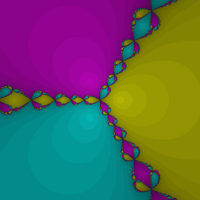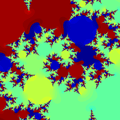Newton fractal

The Newton fractal is a boundary set in the complex plane which is characterized by Newton's method applied to a fixed polynomial or transcendental function. It is the Julia set of the meromorphic function which is given by Newton's method. When there are no attractive cycles (of order greater than 1), it divides the complex plane into regions , each of which is associated with a root of the polynomial, . In this way the Newton fractal is similar to the Mandelbrot set, and like other fractals it exhibits an intricate appearance arising from a simple description. It is relevant to numerical analysis because it shows that (outside the region of quadratic convergence) the Newton method can be very sensitive to its choice of start point.
Many points of the complex plane are associated with one of the roots of the polynomial in the following way: the point is used as starting value for Newton's iteration , yielding a sequence of points If the sequence converges to the root , then was an element of the region . However, for every polynomial of degree at least 2 there are points for which the Newton iteration does not converge to any root: examples are the boundaries of the basins of attraction of the various roots. There are even polynomials for which open sets of starting points fail to converge to any root: a simple example is , where some points are attracted by the cycle 0, 1, 0, 1 ... rather than by a root.
An open set for which the iterations converge towards a given root or cycle (that is not a fixed point), is a Fatou set for the iteration. The complementary set to the union of all these, is the Julia set. The Fatou sets have common boundary, namely the Julia set. Therefore each point of the Julia set is a point of accumulation for each of the Fatou sets. It is this property that causes the fractal structure of the Julia set (when the degree of the polynomial is larger than 2).
To plot interesting pictures, one may first choose a specified number of complex points and compute the coefficients of the polynomial
- .
Then for a rectangular lattice , , of points in , one finds the index of the corresponding root and uses this to fill an × raster grid by assigning to each point a colour . Additionally or alternatively the colours may be dependent on the distance , which is defined to be the first value such that for some previously fixed small .
Generalization of Newton fractals
A generalization of Newton's iteration is
where is any complex number.[1] The special choice corresponds to the Newton fractal. The fixed points of this map are stable when lies inside the disk of radius 1 centered at 1. When is outside this disk, the fixed points are locally unstable, however the map still exhibits a fractal structure in the sense of Julia set. If is a polynomial of degree , then the sequence is bounded provided that is inside a disk of radius centered at .
More generally, Newton's fractal is a special case of a Julia set.
 Newton fractal for three degree-3 roots (), coloured by number of iterations required
Newton fractal for three degree-3 roots (), coloured by number of iterations required Newton fractal for three degree-3 roots (), coloured by root reached
Newton fractal for three degree-3 roots (), coloured by root reached Newton fractal for . Points in the red basins do not reach a root.
Newton fractal for . Points in the red basins do not reach a root. Newton fractal for a 7th order polynomial, colored by root reached and shaded by rate of convergence.
Newton fractal for a 7th order polynomial, colored by root reached and shaded by rate of convergence. Newton fractal for
Newton fractal for Newton fractal for , coloured by root reached, shaded by number of iterations required.
Newton fractal for , coloured by root reached, shaded by number of iterations required. Newton fractal for , coloured by root reached, shaded by number of iterations required
Newton fractal for , coloured by root reached, shaded by number of iterations required_detail.png) Another Newton fractal for
Another Newton fractal for Generalized Newton fractal for , The colour was chosen based on the argument after 40 iterations.
Generalized Newton fractal for , The colour was chosen based on the argument after 40 iterations. Generalized Newton fractal for ,
Generalized Newton fractal for , Generalized Newton fractal for ,
Generalized Newton fractal for , Generalized Newton fractal for ,
Generalized Newton fractal for ,


See also
References
| Wikimedia Commons has media related to Newton fractals. |
- ↑ Simon Tatham. "Fractals derived from Newton–Raphson".
- J. H. Hubbard, D. Schleicher, S. Sutherland: How to Find All Roots of Complex Polynomials by Newton's Method, Inventiones Mathematicae vol. 146 (2001) – with a discussion of the global structure of Newton fractals
- On the Number of Iterations for Newton's Method by Dierk Schleicher July 21, 2000
- Newton's Method as a Dynamical System by Johannes Rueckert
